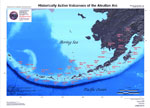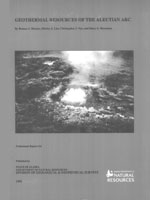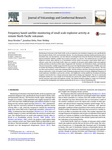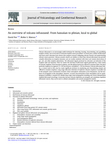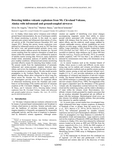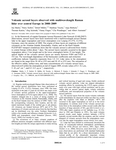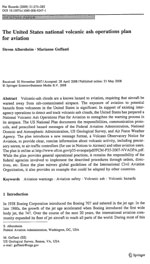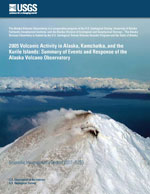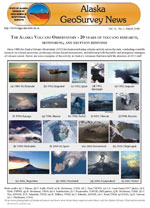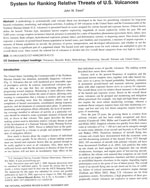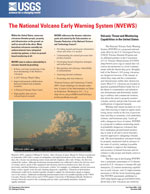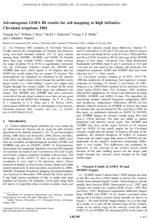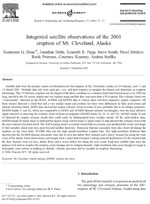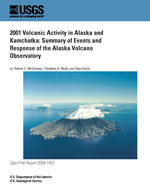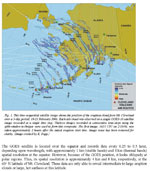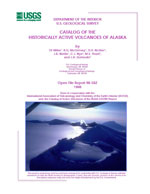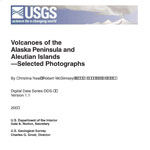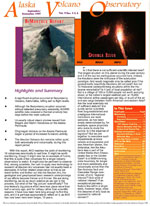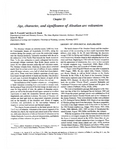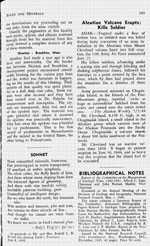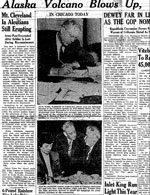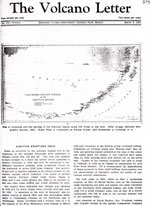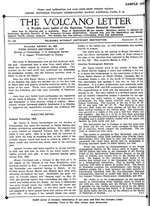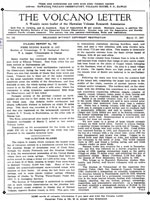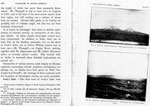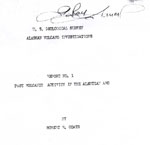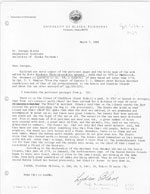References
Orr, T.R., Dietterich, H.R., Grapenthin, R., Haney, M.M., Loewen, M.W., Saunders-Schultz, P., Tan, D., Waythomas, C.F., and Wech, A.G., 2025, 2022 Volcanic activity in Alaska and the Northern Mariana Islands-Summary of events and response of the Alaska Volcano Observatory: U.S. Geological Survey Scientific Investigations Report 2024-5108, 46 p. https://doi.org/ 10.3133/sir20245108
Saunders-Schultz, P., Lopez, T., Dietterich, H., and Girona, T., 2024, Automatic identification and quantification of volcanic hotspots in Alaska using HotLINK - the hotspot learning and identification network: Frontiers in Earth Science v. 12, 1345104. https://doi.org/10.3389/feart.2024.1345104
Orr, T., Cameron, C.E., Dietterich, H.R., Loewen, M.W., Lopez, T., Lyons, J.J., Nakai, J., Power, J.A., Searcy, C., Tepp, G., and Waythomas, C.W., 2024, 2020 Volcanic activity in Alaska - Summary of events and response of the Alaska Volcano Observatory: U.S. Geological Survey Scientific Investigations Report 2024-5004, 34 p. https://doi.org/10.3133/sir20245004.
Orr, T.R., Dietterich, H.R., Fee D., Girona, T., Grapenthin, R., Haney, M.M., Loewen, M.W., Lyons, J.J., Power, J.A., Schwaiger, H.F., Schneider, D.J., Tan, D., Toney, L., Wasser, V.K., and Waythomas, C.F., 2024, 2021 Volcanic activity in Alaska and the Commonwealth of the Northern Mariana Islands - Summary of events and response of the Alaska Volcano Observatory: U.S. Geological Survey Scientific Investigations Report 2024-5014, 64 p. https://doi.org/10.3133/sir20245014.
Wang, J., 2024, Deformation mapping and modeling of the Aleutian volcanoes with InSAR and numerical models: University Park, Tex., Southern Methodist University, Ph.D. dissertation, 143 p.
Sanders-Schultz, P., 2024, Deep learning detection and quantification of volcanic thermal signals in infrared satellite data: Fairbanks, Alaska, University of Alaska Fairbanks, M.S. thesis, 64 p.
Poland, M.P., 2024, Remote sensing of volcano deformation and surface change in Chaussard, E., and others, eds., Remote sensing for characterization of geohazards and natural resources: Cham, Switzerland, Springer, p. 173-203. https://doi.org/10.1007/978-3-031-59306-2_9
Cameron, C.E., Bull, K.F., and Macpherson, A.E., 2023, Recently active volcanoes of Alaska: Alaska Division of Geological & Geophysical Surveys Miscellaneous Publication 133 v. 6, 2 sheets. https://doi.org/10.14509/31086.
Wang, J., Lu, Z., Bekaert, D., Marshak, C., Govorcin, M., Sangha, S., Kennedy, J., and Gregg, P., 2023, Along-arc volcanism in the western and central Aleutian from 2015 to 2021 revealed by cloud-based InSAR processing: Geophysical Research Letters v. 50, no. 23, e2023GL106323. https://doi.org/10.1029/2023GL106323
Marchese, F., and Genzano, N., 2023, Global volcano monitoring through the Normalized Hotspot Indices (NHI) system: Journal of the Geological Society v. 180, no. 1, jgs2022-014. https://doi-org.uaf.idm.oclc.org/10.1144/jgs2022-014
Alaska Volcano Observatory, National Oceanic and Atmospheric Administration, National Weather Service, Federal Aviation Administration, Department of Defense, United States Coast Guard, Division of Homeland Security and Emergency Management, Alaska Department of Environmental Conservation, and Alaska Department of Health and Social Services (participating agencies), 2022, Alaska interagency operating plan for volcanic ash episodes, 85 p.
Dai, Chunli, Howat, I.M., Freymeuller, J.T., Lu, Zhong, Vijay, Saurabh, Liljedahl, A.K., Ward Jones, M.K., Bergstedt, Helena, and Lev, Einat, 2022, Quantifying mass flows at Mt. Cleveland, Alaska between 2001 and 2020 using satellite photogrammetry: Journal of Volcanology and Geothermal Research, v. 429, 11 p., 10.1016/j.jvolgeores.2022.107614.
Cameron, C.E., Crass, S.W., and AVO Staff, eds, 2022, Geologic database of information on volcanoes in Alaska (GeoDIVA): Alaska Division of Geologic and Geophysical Surveys Digital Data Series 20, https://doi.org/10.14509/geodiva, https://doi.org/10.14509/30901.
Reath, K., Pritchard, M.E., Roman, D.C., Lopez, T., Carn, S., Fischer, T.P., Lu, Z., Poland, M.P., Vaughan, R.G., Wessels, R., Wike, L.L., and Tran, H.K., 2021, Quantifying eruptive and background seismicity, deformation, degassing, and thermal emissions at volcanoes in the United States during 1978-2020: Journal of Geophysical Research: Solid Earth, v. 126, e2021JB021684, doi: 10.1029/2021JB021684.
Power, J.A., Roman, D.C., Lyons, J.J., Haney, M.M., Rasmussen, D.J., Plank, Terry, Nicolaysen, K.P., Izbekov, Pavel, Werner, Cynthia, Kaufman, A.M., 2021, Volcanic seismicity beneath Chuginadak Island, Alaska (Cleveland and Tana volcanoes): implications for magma dynamics and eruption forecasting: Journal of Volcanology and Geothermal Research, v. 412, no.107182, 18 p., 10.1016/j.jvolgeores.2021.107182.
Manta, Fabio, Occhipinti, Giovanni, Hill, E.M., Perttu, Anna, Assink, Jelle, and Taisne, Benoit, 2021, Correlation between GNSS-TEC and eruption magnitude supports the use of ionospheric sensing to complement volcanic hazard assessment: Journal of Geophysical Research: Solid Earth, v. 126, no. 2, p. 1-17. doi.org/10.1029/2020JB020726.
Janiszewski, H.A., Wagner, L.S., and Roman, D.C., 2020, Aseismic mid-crustal magma reservoir at Cleveland Volcano imaged through novel receiver function analyses: Scientific Reports, v. 10, doi.org/10.1038/s41598-020-58589-0.
Cameron, C.E., Schaefer, J.R., and Ekberg, P.G., 2020, Historically active volcanoes of Alaska: Alaska Division of Geological & Geophysical Surveys Miscellaneous Publication 133 v. 4, 2 sheets. Http://doi.org/10.14509/30426
Sanderson, R.W., Matoza, R.S., Fee, David, Haney, M.M., and Lyons, J.J., 2020, Remote detection and location of explosive volcanism in Alaska with the EarthScope Transportable Array: Journal of Geophysical Research: Solid Earth, v. 125, 23 p., doi: https://doi.org/10.1029/2019JB018347
Poland, M.P., Lopez, Taryn, Wright, Robert, and Pavolonis, M.J., 2020, Forecasting, detecting, and tracking volcanic eruptions from space: Remote Sensing in Earth Systems Science, 40 p., https://doi.org/10.1007/s41976-020-00034-x
Plank, T., Rasmussen, D., Stelling, P., and Roman, D., 2020, Field report for the collection of mafic tephra from the Aleutian Islands between Unimak and the Islands of Four Mountains (Alaska, USA), version 1.0: Interdisciplinary Earth Data Alliance (IEDA), https://doi.org/10.26022/IEDA/111584. Accessed 2020-06-25.
Cameron, C.E., Dixon, J.P., Waythomas, C.F., Iezzi, A.M., Wallace, K.L., McGimsey, R.G., and Bull, K.F., 2020, 2016 Volcanic activity in Alaska-Summary of events and response of the Alaska Volcano Observatory: U.S. Geological Survey Scientific Investigations Report 2020-5125, 63 p., https://doi.org/10.3133/sir20205125.
Dixon, J.P., Cameron, C.E., Iezzi, A.M., Power, J.A., Wallace, K., and Waythomas, C.F., 2020, 2017 Volcanic activity in Alaska-Summary of events and response of the Alaska Volcano Observatory: U.S. Geological Survey Scientific Investigations Report 2020-5102, 61 p., https://doi.org/10.3133/sir20205102.
Portner, D.E., Wagner, L.S., Janiszewski, H.A., Roman, D.C., and Power, J.A., 2020, Ps-P tomography of a midcrustal magma reservoir beneath Cleveland volcano, Alaska: Geophysical Research Letters, v. 47, article no. e2020GL090406, 10 p., https://doi.org/10.1029/2020GL090406.
Werner, Cindy, Rasmussen, D. J., Plank, Terry, Kelly, P. J., Kern, Christoph, Lopez, Taryn, Gliss, Jonas, Power, J.A., Roman, D.C., Izbekov, Pavel, and Lyons, John, 2020, Linking subsurface to surface using gas emission and melt inclusion data at Mount Cleveland volcano, Alaska: Geochemistry, Geophysics, Geosystems, v. 125, article no. e2019GC008882, 33 p. https://doi.org/10.1029/2019GC008882.
Iezzi, A.M., Fee, David, Haney, M.M., and Lyons, J.J., 2020, Seismo-acoustic characterization of Mount Cleveland Volcano explosions: Frontiers in Earth Science, v. 8, no. 573368, 19 p., doi:10.3389/feart.2020.573368.
Kelly, P.J., Kern, Christoph, Werner, C.A., and Lopez, Taryn, 2020, Volcanic gas measurements at Mount Cleveland, Alaska 2016: U.S. Geological Survey data release, https://doi.org/10.5066/P9DRMV0U..
Rasmussen, D.J., and Plank, T.A., 2020, Bulk rock data for Cleveland volcano, version 1.0: Interdisciplinary Earth Data Alliance (IEDA). https://doi.org/10.26022/IEDA/111541.
Plank, T., Rasmussen, D. J., Stelling, P., and Roman, D. C., 2020, Field report for the collection of mafic tephra from the Aleutians Islands between Unimak and the Island of Four Mountains (Alaska, USA), version 1.0: Interdisciplinary Earth Data Alliance (IEDA). https://doi.org/10.26022/IEDA/111584
Iezzi, A.M., Schwaiger, H.F., Fee, D., and Haney, M.M., 2019, Application of an updated atmospheric model to explore volcano infrasound propagation and detection in Alaska: Journal of Volcanology and Geothermal Research, v. 371, p. 192-205, doi:10.1016/j.volgeores.2018.03.009.
Schwaiger, H.F., Iezzi, A.M., and Fee, David, 2019, AVO-G2S: A modified, open-source Ground-to-Space atmospheric specification for infrasound modeling: Computers and Geosciences, v. 125, p. 90-97, doi:10.1016/j.cageo.2018.12.013.
Dixon, J.P., Stihler S.D., Haney, M.M., Lyons, J.J., Ketner, D.M., Mulliken, K.M., Parker, T., and Power, J.A., 2019, Catalog of earthquake parameters and description of seismograph and infrasound stations at Alaskan volcanoes - January 1, 2013, through December 31, 2017: U.S. Geological Survey Data Series 1115, 92 p., https://doi.org/10.3133/ds1115.
Power, J.A., Friberg, P.A., Haney, M.M., Parker, T., Stihler, S.D., and Dixon, J.P., 2019, A unified catalog of earthquake hypocenters and magnitudes at volcanoes in Alaska—1989 to 2018: U.S. Geological Survey Scientific Investigations Report 2019–5037, 17 p., https://doi.org/10.3133/sir20195037.
Westberry, T.K., Shi, Y.R., Yu, H., Behrenfeld, M.J., and Remer, L.A., 2019, Satellite-detected ocean ecosystem response to volcanic eruptions in the subarctic Northeast Pacific Ocean: Geophysical Research Letters, v. 6, n. 20, p. 11270-11280, doi: http://dx.doi.org/10.1029/2019GL083977.
Rasmussen, D.J., and Plank, T.A., 2019, Bulk rock data for the central-eastern Aleutian volcanoes, version 1.0: Interdisciplinary Earth Data Alliance (IEDA). https://doi.org/10.26022/IEDA/111870
Mulliken, K.M., 2018, The Alaska Volcano Observatory: 30 years of protecting Alaskans from the effects of volcanic activity (1988-2018): Alaska Division of Geological & Geophysical Surveys Information Circular 67, 2 p. http://doi.org/10.14509/30032
Ewert, J.W., Diefenbach, A.K., and Ramsey, D.W., 2018, 2018 update to the U.S. Geological Survey national volcanic threat assessment: U.S. Geological Survey Scientific Investigations Report 2018-5140, 40 p., https://pubs.usgs.gov/sir/2018/5140/sir20185140.pdf.
Cameron, C.E., Schaefer, J.R., and Mulliken, K.M., 2018, Historically active volcanoes of Alaska: Alaska Division of Geological & Geophysical Surveys Miscellaneous Publication 133 v. 3, 2 sheets. Http://doi.org/10.14509/30142
Werner, Cynthia, Kern, Christoph, Coppola, Diego, Lyons, J.J., Kelly, P.J., Wallace, K.L., Schneider, D.J., and Wessels, R.L., 2017, Magmatic degassing, lava dome extrusion, and explosions from Mount Cleveland volcano, Alaska, 2011-2015: Insights into the continuous nature of volcanic activity over multi-year timescales: Journal of Volcanology and Geothermal Research, 13 p. doi: http://dx.doi.org/10.1016/j.jvolgeores.2017.03.001
Associated Press, 2017, 2 Alaska volcanoes erupt just hours apart: Anchorage Daily News article published online May 17, 2017, available at https://www.adn.com/alaska-news/science/2017/05/17/2-alaska-volcanoes-erupt-just-hours-apart/
Klemetti, E., 2017, Volcanic Explosions Rock an Alaskan Island as Etna Rumbles: Wired article published online May 19, 2017, available at https://www.wired.com/2017/05/volcanic-explosions-rock-alaskan-island-etna-rumbles/
Lill, A., 2017, Three Alaska Peninsula volcanoes are restless: KDLG Dillingham, Alaska article published online June 9, 2017, available at http://kdlg.org/post/three-alaska-peninsula-volcanoes-are-restless#stream/0
Webley, P., Patra, A., Bursik, M., Pitman, E.B., Dehn, J., Singh, T., Singla, P., Jones, M.D., Madankan, R., Stefanescu, E.R., and Pouget, S., 2017, Building an uncertainty modeling framework for real-time VATD: Natural Hazard Uncertainty Assessment: Modeling and Decision Support, Geophysical Monograph 223, p. 59-88.
Cameron, C.E., Dixon, J.P., Neal, C.A., Waythomas, C.F., Schaefer, J.R., and McGimsey, R.G., 2017, 2014 Volcanic activity in Alaska - Summary of events and response of the Alaska Volcano Observatory: U.S. Geological Survey Scientific Investigations Report 2017-5077, 81 p., https://doi.org/10.3133/sir20175077.
Dixon, J.P., Cameron, C.E., Iezzi, A.M., and Wallace, Kristi, 2017, 2015 Volcanic activity in Alaska-Summary of events and response of the Alaska Volcano Observatory: U.S. Geological Survey Scientific Investigations Report 2017-5104, 61 p., https://doi.org/10.3133/sir20175104.
Cameron, C.E., and Schaefer, J.R., 2016, Historically active volcanoes of Alaska: Alaska Division of Geological & Geophysical Surveys Miscellaneous Publication 133 v. 2, 1 sheet, scale 1:3,000,000. http://doi.org/10.14509/20181
Fee, D., Haney, M., Matoza, R., Szuberla, C., Lyons, J., and Waythomas, C., 2016, Seismic Envelope‐Based Detection and Location of Ground‐Coupled Airwaves from Volcanoes in Alaska: Bulletin of the Seismological Society of America, v. 106, n. 3, p. 1-12.
Cameron, C.E., and Snedigar, S.F., 2016, Alaska Volcano Observatory image database: Alaska Division of Geological & Geophysical Surveys Digital Data Series 13, https://www.avo.alaska.edu/images/. https://doi.org/10.14509/29689.
McNutt, S.R., Thompson, G., Johnson, J.B., De Angelis, S., and Fee, D., 2015, Seismic and infrasound monitoring: in Sigurdsson, H., Houghton, B.F., Rymer, H., Stix, J., and McNutt, S. (eds.), The encyclopedia of volcanoes (2nd ed): Academic Press, p. 1071-1099, http://dx.doi.org/10.1016/B978-0-12-385938-9.00063-8
Dixon, J.P., Cameron, Cheryl, McGimsey, R.G., Neal, C.A., and Waythomas, Chris, 2015, 2013 Volcanic activity in Alaska - Summary of events and response of the Alaska Volcano Observatory: U.S. Geological Survey Scientific Investigations Report 2015-5110, 92 p., http://dx.doi.org/10.3133/sir20155110.
Wang, Teng, Poland, M.P., and Lu, Zhong, 2015, Dome growth at Mount Cleveland, Aleutian Arc, quantified by time series TerraSAR-X imagery: Geophysical Research Letters, v. 42, p. 10614-10621.
Schaefer, J.R., Cameron, C.E., and Nye, C.J., 2014, Historically active volcanoes of Alaska: Alaska Division of Geological & Geophysical Surveys Miscellaneous Publication 133 v. 1.2, 1 sheet, scale 1:3,000,000.
This publication has been superseded. Newest version available at http://www.dggs.alaska.gov/pubs/id/20181 .
Neal, C.A., Herrick, J., Girina, O.,A., Chibisova, M., Rybin, A., McGimsey, R.G., and Dixon, J., 2014, 2010 Volcanic activity in Alaska, Kamchatka, and the Kurile Islands - Summary of events and response of the Alaska Volcano Observatory: U.S. Geological Survey Scientific Investigations Report 2014-5034, 76 p., http://dx.doi.org/10.3133/sir20145034 .
Herrick, J.A., Neal, C.A., Cameron, C.E., Dixon, J.P., and McGimsey, R.G., 2014, 2012 Volcanic activity in Alaska: Summary of events and response of the Alaska Volcano Observatory: U.S. Geological Survey Scientific Investigations Report 2014-5160, 82p., http://dx.doi.org/10.3133/sir20145160.
Cameron, C.E., and Nye, C.J., 2014, Preliminary database of Quaternary vents in Alaska: Alaska Division of Geological & Geophysical Surveys Miscellaneous Publication 153, 11 p., doi:10.14509/27357 .
McGimsey, R.G., Maharrey, J.Z., and Neal, C.A., 2014, 2011 Volcanic activity in Alaska: Summary of events and response of the Alaska Volcano Observatory: U.S. Geological Survey Scientific Investigations Report 2014-5159, 50 p., http://dx.doi.org/10.3133/sir20145159.
Worden, Anna, Dehn, Jonathan, and Webley, Peter, 2014. Frequency based satellite monitoring of small scale explosive activity at remote North Pacific volcanoes: Journal of Volcanology and Geothermal Research, v. 286, 14 p., http://dx.doi.org/10.1016/j.jvolgeores.2014.08.019
Lu, Zhong, and Dzurisin, Daniel, 2014, InSAR imaging of Aleutian volcanoes: Chichester, UK, Springer-Praxis, 390 p.
Worden, A. K., 2014, Monitoring small scale explosive activity as a precursor to periods of heightened volcanic unrest: University of Alaska Fairbanks M.S. thesis, 126 p.
Fee, David, and Matoza, R.S., 2013, An overview of volcano infrasound: from hawaiian to plinian, local to global: Journal of Volcanology and Geothermal Research, v. 249, p. 123-139, doi: 10.1016/j.jvolgeores.2012.09.002 .
Guffanti, Marianne, and Miller, Tom, 2013, A volcanic activity alert-level system for aviation: review of its development and application in Alaska: Natural Hazards, 15 p., doi:0.1007/s11069-013-0761-4
Dixon, J.P., Stihler, S.D, Power, J.A., Haney, Matt, Parker, Tom, Searcy, C.K., and Prejean, Stephanie, 2013, Catalog of earthquake hypocenters at Alaskan volcanoes: January 1 through December 31, 2012: U.S. Geological Survey Data Series 789, 84 p., available at http://pubs.usgs.gov/ds/789/ .
Dixon, J.P., Stihler, S.D., Power, J.A., and Searcy, C.K., 2012, Catalog of earthquake hypocenters at Alaskan volcanoes: January 1 through December 31, 2011: U.S. Geological Survey Data Series 730, 82 p., available online at http://pubs.usgs.gov/ds/730/pdf/ds730.pdf .
De Angelis, Silvio, Fee, David, Haney, Matthew, and Schneider, David, 2012, Detecting hidden volcanic explosions from Mt. Cleveland volcano, Alaska, with infrasound and ground-coupled airwaves: Geophysical Research Letters, v. 39, L21312, 6 p., doi: 10.1029/2012GL053635 .
McGimsey, R.G., Neal, C.A., Dixon, J.P., Malik, Nataliya, and Chibisova, Marina, 2011, 2007 Volcanic activity in Alaska, Kamchatka, and the Kurile Islands: Summary of events and response of the Alaska Volcano Observatory: U.S. Geological Survey Scientific Investigations Report 2010-5242, 110 p. Available online at http://pubs.usgs.gov/sir/2010/5242/ .
Neal, C.A., McGimsey, R.G., Dixon, J.P., Cameron, C.E., Nuzhaev, A.A., and Chibisova, Marina, 2011, 2008 Volcanic activity in Alaska, Kamchatka, and the Kurile Islands: Summary of events and response of the Alaska Volcano Observatory: U.S. Geological Survey Scientific Investigations Report 2010-5243, 94 p., available at http://pubs.usgs.gov/sir/2010/5243 .
Dabrowa, A.L., Green, D.N., Rust, A.C., and Phillips, J.C., 2011, A global study of volcanic infrasound characteristics and the potential for long-range monitoring: Earth and Planetary Science Letters, v. 310, p. 369-379, doi:10.1016/j.epsl.2011.08.027.
Dixon, J.P., Stihler, S.D., Power, J.A., and Searcy, C.K., 2011, Catalog of earthquake hypocenters at Alaskan volcanoes: January 1 through December 31, 2010: U.S. Geological Survey Data Series 645, 82 p., available online at http://pubs.usgs.gov/ds/645/
Dixon, J.P., Stihler, S.D., Power, J.A., and Searcy, C.K., 2010, Catalog of earthquake hypocenters at Alaskan volcanoes: January 1 through December 31, 2009: U.S. Geological Survey Data Series 531, 84 p., available online at http://pubs.usgs.gov/ds/531/ .
Yogodzinski, G.M., Vervoort, J.D., Brown, S.T., and Gerseny, M., 2010. Subduction controls of Hf and Nd isotopes in lavas of the Aleutian island arc: Earth and Planetary Science Letters, v. 300, p. 226-238, doi: 10.1016/j.epsl.2010.09.035 .
Guffanti, Marianne, Casadevall, T.J., and Budding, Karin, 2010, Encounters of aircraft with volcanic ash clouds: A compilation of known incidents, 1953-2009: U.S. Geological Data Series 545, ver. 1.0, 12 p., plus 4 appendixes including the compliation database, available only at http://pubs.usgs.gov/ds/545 .
Mattis, Ina, Seifert, Patric, Muller, Detlef, Tesche, Matthias, Hiebsch, Anja, Kanitz, Thomas, Schmidt, Jorg, Finger, Fanny, Wandinger, Ulla, and Ansmann, Albert, 2010, Volcanic aerosol layers observed with multiwavelength Raman lidar over central Europe in 2008-2009: Journal of Geophysical Research, v. 115, n. D00L04, 9 p., doi:10.1029/2009JD013472 .
University of Alaska Fairbanks Geophysical Institute, 2010, Geophysical Institute, 2007-2010 report: 48 p., available online at http://www.gi.alaska.edu/admin/info/gireport
Neal, C.A., McGimsey, R.G., Dixon, J.P., Manevich, Alexander, and Rybin, Alexander, 2009, 2006 Volcanic activity in Alaska, Kamchatka, and the Kurile Islands: Summary of events and response of the Alaska Volcano Observatory: U.S. Geological Survey Scientific Investigations Report 2008-5214, 102 p., available at http://pubs.usgs.gov/sir/2008/5214/ .
Waythomas, C.F., Watts, Philip, Shi, Fengyan, and Kirby, J.T., 2009, Pacific Basin tsunami hazards associated with mass flows in the Aleutian arc of Alaska: Quaternary Science Reviews, v. 28, p. 1006-1019, doi:10.1016/j.quascirev.2009.02.019 .
Dixon, J.P., and Stihler, S.D., 2009, Catalog of earthquake hypocenters at Alaskan volcanoes: January 1 through December 31, 2008: U.S. Geological Survey Data Series 467, 88 p., available at http://pubs.usgs.gov/ds/467/ .
Webley, Peter, and Mastin, Larry, 2009, Improved prediction and tracking of volcanic ash clouds: Journal of Volcanology and Geothermal Research, v. 186, n. 1-2, p. 1-9, doi:10.1016/j.jvolgeores.2008.10.022 .
Webley, P.W., Dehn, J., Lovick, J., Dean, K.G., Bailey, J.E., and Valcic, L., 2009, Near-real-time volcanic ash cloud detection: Experiences from the Alaska Volcano Observatory: Journal of Volcanology and Geothermal Research, v. 186, n. 1-2, p. 79-90, doi:10.1016/j.jvolgeores.2009.02.010 .
Webley,P.W., Dean, Kenneson, Bailey, J.E., Dehn, Jon, and Peterson, Rorik, 2009, Automated forecasting of volcanic ash dispersion utilizing Virtual Globes: Natural Hazards, v. 51, p. 345-361, doi: 10.1007/s11069-008-9246-2 .
Albersheim, Steven, and Guffanti, Marianne, 2009, The United States national volcanic ash operations plan for aviation: Natural Hazards, v. 51, p. 275-285, doi:10.1007/s11069-008-9247-1 .
Snedigar, S.F., and Cameron, C.C., 2009, Historically active volcanoes of Alaska reference deck: Alaska Division of Geological & Geophysical Surveys Information Circular 59, 52 p, available to order from http://www.dggs.dnr.state.ak.us/pubs/pubs?reqtype=citation&ID=20401 .
Kearney, C.S., and Watson, I.M., 2009, Correcting satellite-based infrared sulfur dioxide retrivals for the presence of silicate ash: Journal of Geophysical Research, v. 114, n. D22, 12 p., doi:10.1029/2008JD011407 .
Diefenbach, A.K., Guffanti, Marianne, and Ewert, J.W., 2009, Chronology and references of volcanic eruptions and selected unrest in the United States, 1980-2008: U.S. Geological Survey Open-File Report 2009-1118, 85 p., available at http://pubs.usgs.gov/of/2009/1118/ .
McGimsey, R.G., Neal, C.A., Dixon, J.P., and Ushakov, Sergey, 2008, 2005 Volcanic activity in Alaska, Kamchatka, and the Kurile Islands: Summary of events and response of the Alaska Volcano Observatory: U.S. Geological Survey Scientific Investigations Report 2007-5269, 94 p., available at http://pubs.usgs.gov/sir/2007/5269/ .
Schaefer, J.R., and Nye, Chris, 2008, The Alaska Volcano Observatory - 20 years of volcano research, monitoring, and eruption response: Alaska Division of Geological & Geophysical Surveys, Alaska GeoSurvey News, NL 2008-001, v. 11, n. 1, p. 1-9, available at http://wwwdggs.dnr.state.ak.us/pubs/pubs?reqtype=citation&ID=16061 .
University of Alaska Fairbanks Geophysical Institute, 2008, 20th anniversary of the Alaska Volcano Observatory: University of Alaska Geophysical Institute pamphlet, 2 p.
Peterson, R.A., and Dean, K.G., 2008, Forecasting exposure to volcanic ash based on ash dispersion modeling: Journal of Volcanology and Geothermal Research, v. 170, p. 230-246, doi:10.1016/j.jvolgeores.2007.10.003.
Moran, S.C., Freymueller, J.T., LaHusen, R.G., McGee, K.A., Poland, M.P., Power, J.A., Schmidt, D.A., Schneider, D.J., Stephens, G., Werner, C.A., and White, R.A., 2008, Instrumentation recommendations for volcano monitoring at U.S. volcanoes under the National Volcano Early Warning System: U.S. Geological Survey Scientific Investigations Report 2008-5114, 47 p., available online at http://pubs.usgs.gov/sir/2008/5114/ .
Adleman, J.N., Cameron, C.E., Neal, T.A., and Shipman, J.S., 2008, Hazards communication by the Alaska Volcano Observatory concerning the 2008 eruptions of Okmok and Kasatochi volcanoes, Aleutian Islands, Alaska [abs.]: Eos fall meeting supplementary, Eos, v, 89, n. 53, abstract A53b-0275.
van Manen, S., and Dehn, J., 2008, Debris flows associated with lava extrusion at three stratocones: Cleveland, Pavlof (Alaska) and Stromboli (Italy) [abs.]: Eos, Transactions, American Geophysical Union, v. 89, n. 53, 1 p.
Kearney, C., and Watson, I.M., 2008, Investigation into the effect of silicate ash on the 8.6 mu m sulfur dioxide retrieval in the North Pacific region [abs.]: Eos, Transactions, American Geophyiscal Union, v. 89, n. 53, 1p.
Meleney, P., Nicolaysen, K.P., and Dehn, J., 2008, Petrogenic modeling of pre-2004 lavas from Mt. Cleveland, Chuginadak Island, AK [abs.]: Eos, Transactions, American Geophysical Union, v. 89, n. 53, 1 p.
Ewert, John, 2007, System for ranking relative threats of U.S. volcanoes: Natural Hazards Review, v. 8, n. 4, p. 112-124.
Anchorage Daily News, 2006, Cleveland Volcano spits ash 20,000 feet: Anchorage Daily News, Monday, October 30, 2006, p. B-3.
Dixon, J.P., Stihler, S.D., Power, J.A., Tytgat, Guy, Estes, Steve, and McNutt, S.R., 2006, Catalog of earthquake hypocenters at Alaskan volcanoes: January 1 through December 31, 2005: U.S. Geological Survey Open-File Report 2006-1264, 78 p., available at http://pubs.usgs.gov/of/2006/1264/ .
Ewert, John, Guffanti, Marianne, Cervelli, Peter, and Quick, James, 2006, The National Volcano Early Warning System (NVEWS): U.S. Geological Survey Fact Sheet FS 2006-3142, 2 p., available at http://pubs.usgs.gov/fs/2006/3142 .
Smithsonian Institution, 2006, Cleveland: Bulletin of the Global Volcanism Network, v. 31, n. 1, available at http://www.volcano.si.edu/world/volcano.cfm?vnum=1101-24-&volpage=var#bgvn_3101 .
Smithsonian Institution, 2006, Cleveland: Bulletin of the Global Volcanism Network, v. 31, n. 6, available at http://www.volcano.si.edu/world/volcano.cfm?vnum=1101-24-&volpage=var#bgvn_3106 .
Smithsonian Institution, 2006, Cleveland: Bulletin of the Global Volcanism Network, v. 31, n. 7, available at http://www.volcano.si.edu/world/volcano.cfm?vnum=1101-24-&volpage=var#bgvn_3107 .
Smithsonian Institution, 2006, Cleveland: Bulletin of the Global Volcanism Network, v. 31, n. 9, available at http://www.volcano.si.edu/world/volcano.cfm?vnum=1101-24-&volpage=var#bgvn_3109 .
Gu, Yingxin, Rose, William I., Schneider, David J., Bluth, Gregg J. S., and Watson, I. M., 2005, Advantageous GOES IR results for ash mapping at high latitudes: Cleveland eruptions 2001: Geophysical Research Letters, v. 32, 5 pages.
Smith, S.J., 2005, Chronologic multisensor assessment for Mount Cleveland, Alaska from2000 to 2004 focusing on the 2001 eruption: University of Alaska Fairbanks M.S. thesis, 142 p., available at http://www.avo.alaska.edu/downloads/ .
Ewert, J.W., Guffanti, Marianne, and Murray, T.L., 2005, An assessment of volcanic threat and monitoring capabilities in the United States: framework for a National Volcano Early Warning System NVEWS: U.S. Geological Survey Open-File Report 2005-1164, 62 p.
Alaska Volcano Observatory, 2005, March-April 2005: Alaska Volcano Observatory Bimonthly report, v. 17, n. 2, unpaged, http://www.avo.alaska.edu/avobm/avo_info.php?volume=17&number=2.
Alaska Volcano Observatory, 2005, May-June 2005: Alaska Volcano Observatory Bimonthly report, v. 17, n. 3, unpaged, http://www.avo.alaska.edu/avobm/introduction.php?volume=17&number=3.
Alaska Volcano Observatory, 2005, July-August 2005: Alaska Volcano Observatory Bimonthly report, v. 17, n. 4, unpaged, http://www.avo.alaska.edu/avobm/introduction.php?volume=17&number=4.
Papp, K.P., Dean, K.G., and Dehn, J., 2005, Predicting regions susceptible to high concentrations of airborne volcanic ash in the North Pacific region: Journal of Volcanology and Geothermal Research, v. 148, no. 3-4, p. 295-314, doi: 10.1016/j.jvolgeores.2005.04.020.
Smithsonian Institution, 2005, Cleveland: Bulletin of the Global Volcanism Network, v. 30, n. 9, available at http://www.volcano.si.edu/world/volcano.cfm?vnum=1101-24-&volpage=var#bgvn_3009 .
Dean, K. G., Dehn, Jonathan, Papp, K. R., Smith, Steve, Izbekov, Pavel, Peterson, Rorik, Kearney, Courtney, and Steffke, Andrea, 2004, Integrated satellite observations of the 2001 eruption of Mt. Cleveland, Alaska: Journal of Volcanology and Geothermal Research, v. 135, p. 51-73.
Watson, I. M., Prata, A. J., Bluth, G. J. S., Gu, Y., Bader, C. E., Yu, Tianxu, Realmuto, V. J., and Rose, W. I., 2004, Thermal infrared remote sensing of volcanic emissions using the moderate resolution imaging spectroradiometer: Journal of Volcanology and Geothermal Research, v. 135, n. 1-2, p. 75-89.
McGimsey, R.G., Neal, C.A., and Girina, Olga, 2004: 2001 volcanic activity in Alaska and Kamchatka: Summary of events and response of the Alaska Volcano Observatory: U.S. Geological Survey Open-File Report 2004-1453, 53 p.
Spicak, Ales, Hanus, Vaclav, and Vanek, Jiri, 2004, Seismicity pattern: an indicator of source region of volcanism at convergent plate margins: in Spicak, Ales, Cadek, Ondrej, and Engdahl, E.R., eds., Structure and tectonics of convergent plate margins, Physics of the Earth and Planetary Interiors, v. 141, n. 4, p. 303-326.
Siebert, L., and Simkin, T., 2002-, Volcanoes of the world: an illustrated catalog of Holocene volcanoes and their eruptions: Smithsonian Institution, Global Volcanism Program Digital Information Series GVP-3, http://volcano.si.edu/search_volcano.cfm, unpaged internet resource.
Cameron, C. E., Triplehorn, J. H., and Robar, C. L., 2003, Bibliography of information on Alaska volcanoes: Alaska Division of Geological & Geophysical Surveys Miscellaneous Publication MP 131, 1 CD-ROM.
Hard Copy held by AVO at FBKS - CEC file cabinet
Ellrod, G. P., and Jung-Sun, Im, 2003, Development of volcanic ash products using MODIS multi-spectral data: AMS Conference on satellite meterology and oceanography, 12, Long Beach, CA, 9-13 February, unpaged.
Lu, Zhong, Wicks, C. J., Dzurisin, Daniel, Power, John, Thatcher, Wayne, and Masterlark, Tim, 2003, Interferometric synthetic aperture radar studies of Alaska volcanoes: Earth Observation Magazine, v. 12, n. 3, p. 8-10.
Dean, Kenneson, Dehn, Jonathan, McNutt, Steve, Neal, Christina, Moore, Richard, and Schneider, Dave, 2002, Satellite imagery proves essential for monitoring erupting Aleutian volcano: Eos, v. 83, n. 22, p. 241, 246-247.
Hard Copy held by AVO at FBKS - CEC file cabinet
Hillger, D. W., and Clark, J. D., 2002, Principal component image analysis of MODIS for volcanic ash. Part I: Most important bands and implications for future GOES images: Journal of applied meterology, v. 41, n. 10, p. 985-1001.
Hillger, D. W., and Clark, J. D., 2002, Principal component image analysis of MODIS for volcanic ash. Part II: Simulation of current GOES and GOES-M imagers: Journal of applied meterology, v. 41, n. 10, p. 1003-1010.
Simpson, J. J., Hufford, G. L., Pieri, David, Servranckx, Rene, Berg, J. S., and Bauer, Craig, 2002, The February 2001 eruption of Mount Cleveland, Alaska: case study of an aviation hazard: Weather and Forecasting, v. 17, n. 4, p. 691-704.
Hard Copy held by AVO at FBKS - CEC file cabinet
Schaefer, Janet, and Nye, C. J., 2002, Historically active volcanoes of the Aleutian Arc: Alaska Division of Geological & Geophysical Surveys Miscellaneous Publication MP 0123, unpaged, 1 sheet, scale 1:3,000,000. Superceded by Miscellaneous Publication 133: http://www.dggs.dnr.state.ak.us/pubs/pubs?reqtype=citation&ID=20181
Smithsonian Institution, 2001, Cleveland: Global Volcanism Network Bulletin v. 26, n. 01, unpaged.
Smithsonian Institution, 2001, Cleveland: Global Volcanism Network Bulletin v. 26, n. 04, unpaged.
Unknown, 2001, The need to vent: Alaska, v. 67, n. 5, p. 14-17.
Bowermaster, Jon, 2001, Birthplace of the winds: storming Alaska's islands of fire and ice: Washington D.C., National Geographic Society, 304 p.
Alaska Volcano Observatory, 2001, Eruption of Cleveland Volcano: unpaged internet resource.
Wallace, K. L., McGimsey, R. G., and Miller, T. P., 2000, Historically active volcanoes in Alaska, a quick reference: U.S. Geological Survey Fact Sheet FS 0118-00, 2 p.
Hard Copy held by AVO at FBKS - CEC file cabinet
Sigurdsson, Haraldur, (ed.), 2000, Encyclopedia of volcanoes: San Diego, CA, Academic Press, 1417 p.
McGimsey, R. G., and Wallace, K. L., 1999, 1997 volcanic activity in Alaska and Kamchatka: Summary of events and response of the Alaska Volcano Observatory: U.S. Geological Survey Open-File Report 99-0448, 42 p.
Hard Copy held by AVO at FBKS - CEC file cabinet
Nye, C. J., Queen, Katherine, and McCarthy, A. M., 1998, Volcanoes of Alaska: Alaska Division of Geological & Geophysical Surveys Information Circular IC 0038, unpaged, 1 sheet, scale 1:4,000,000, available at http://www.dggs.dnr.state.ak.us/pubs/pubs?reqtype=citation&ID=7043 .
Hard Copy held by AVO at FBKS - CEC shelf
Miller, T. P., McGimsey, R. G., Richter, D. H., Riehle, J. R., Nye, C. J., Yount, M. E., and Dumoulin, J. A., 1998, Catalog of the historically active volcanoes of Alaska: U.S. Geological Survey Open-File Report 98-0582, 104 p.
Hard Copy held by AVO at FBKS - CEC shelf
Neal, Christina, and McGimsey, R. G., 1997, Volcanoes of the Alaska Peninsula and Aleutian Islands selected photographs: U.S. Geological Survey Digital Data Series DDS 0040, 1 CD-ROM.
Alaska Volcano Observatory, 1997, May-June 1997: Alaska Volcano Observatory Bimonthly Report, v. 9, n. 3, 23 p.
Alaska Volcano Observatory, 1997, September-December 1997: Alaska Volcano Observatory Bimonthly Report, v. 9, n. 5 and 6, 17 p.
Neal, C. A., Doukas, M. P., and McGimsey, R. G., 1995, 1994 volcanic activity in Alaska: summary of events and response of the Alaska Volcano Observatory: U.S. Geological Survey Open-File Report 95-0271, 18 p.
Hard Copy held by AVO at FBKS - CEC file cabinet
McGimsey, R. G., and Miller, T. P., 1995, Quick reference to Alaska's active volcanoes and listing of historical eruptions, 1760-1994: U.S. Geological Survey Open-File Report 95-0520, 13 p.
Hard Copy held by AVO at FBKS - CEC file cabinet
Alaska Division of Geological & Geophysical Surveys, 1995, Volcanoes of Alaska: Alaska Division of Geological & Geophysical Surveys Information Circular IC 0038, unpaged, 1 sheet, scale 1:4,000,000.
Kay, S. M., and Kay, R. W., 1994, Aleutian magmas in space and time: in Plafker, George and Berg, H. C., (eds.), The Geology of Alaska, Geological Society of America The Geology of North America series v. G-1, p. 687-722.
Hard Copy held by AVO at FBKS - CEC file cabinet
Simkin, Tom, and Siebert, Lee, 1994, Volcanoes of the world [2nd edition]: Tucson, Arizona, Geoscience Press, 349 p.
Hard Copy held by AVO at FBKS - CEC shelf
Smithsonian Institution, 1994, Cleveland: Global Volcanism Network Bulletin v. 19, n. 05, unpaged.
Smithsonian Institution, 1994, Cleveland: Global Volcanism Network Bulletin v. 19, n. 06, unpaged.
Myers, J. D., 1994, The geology, geochemistry and petrology of the recent magmatic phase of the central and western Aleutian Arc: unpublished manuscript unpaged.
Hard Copy held by AVO at FBKS - CEC shelf
Fournelle, J. H., Marsh, B. D., and Myers, J. D., 1994, Age, character, and significance of Aleutian arc volcanism: in Plafker, George and Berg, H. C., (eds.), The Geology of Alaska, Geological Society of America The Geology of North America Series v. G-1, p. 723-758.
Nye, C. J., 1994, Aleutian arc volcanoes: Alaska Division of Geological & Geophysical Surveys Public-Data File PDF 94-54, unpaged, 1 sheet, scale 1:2,126,841.
Bergsland, Knut, comp., 1994, Aleut dictionary, Unangam Tunudgusii, an unabridged lexicon of the Aleutian, Pribilof, and Commander Islands Aleut language: University of Alaska Fairbanks, Alaska Native Language Center, 739 p.
Motyka, R. J., Liss, S. A., Nye, C. J., and Moorman, M. A., 1993, Geothermal resources of the Aleutian Arc: Alaska Division of Geological & Geophysical Surveys Professional Report PR 0114, 17 p., 4 sheets, scale 1:1,000,000.
Hard Copy held by AVO at FBKS - CEC shelf
March, G. D., 1993, Holocene volcanoes of the Aleutian Arc, Alaska: Alaska Division of Geological & Geophysical Surveys Public-Data File PDF 93-85, unpaged, 1 sheet, scale 1:2,000,000.
Reeder, J. W., 1992, Cleveland: in Annual Report of the World Volcanic Eruptions in 1989, Bulletin of Volcanic Eruptions, v. 29, p. 70-71.
Hard Copy held by AVO at FBKS - CEC file cabinet
Rennick, Penny, (ed.), 1991, Alaska's volcanoes: Alaska Geographic, v. 18, n. 2, 80 p.
Hard Copy held by AVO at FBKS - CEC file cabinet
Unknown, 1991, Alaska's volcanoes - an introduction: in Rennick, Penny, (ed.), Alaska's volcanoes, Alaska Geographic, v. 18, n. 2, p. 5-9.
Wood, C. A., and Kienle, Juergen, (eds.), 1990, Volcanoes of North America: United States and Canada: New York, Cambridge University Press, 354 p.
Hard Copy held by AVO at FBKS - CEC shelf
Reeder, J. W., 1990, Cleveland: in Annual report of the world volcanic eruptions in 1987, Bulletin of Volcanic Eruptions, v. 27, p. 41-44.
Hard Copy held by AVO at FBKS - CEC file cabinet
Reeder, J. W., 1989, Cleveland: in Annual report of the world volcanic eruptions in 1986, Bulletin of Volcanic Eruptions, v. 26, p. 45-47.
Hard Copy held by AVO at FBKS - CEC file cabinet
Reeder, J. W., 1988, Cleveland: in Annual report of the world volcanic eruptions in 1985, Bulletin of Volcanic Eruptions, v. 25, p. 39.
Hard Copy held by AVO at FBKS - CEC file cabinet
Smithsonian Institution, 1987, Cleveland: Scientific Event Alert Network Bulletin v. 12, n. 06, unpaged.
Smithsonian Institution, 1987, Cleveland: Scientific Event Alert Network Bulletin v. 12, n. 07, unpaged.
Smithsonian Institution, 1987, Cleveland: Scientific Event Alert Network Bulletin v. 12, n. 08, unpaged.
Reeder, J. W., 1987, Cleveland: in Annual report of the world volcanic eruptions in 1984, Bulletin of Volcanic Eruptions, v.24, p. 37-38.
Hard Copy held by AVO at FBKS - CEC file cabinet
Luedke, R. G., and Smith, R. L., 1986, Map showing distribution, composition, and age of Late Cenozoic volcanic centers in Alaska: U.S. Geological Survey Miscellaneous Investigations Series Map I 1091-F, unpaged, 3 sheets, scale 1:1,000,000.
Smithsonian Institution, 1986, Cleveland: Scientific Event Alert Network Bulletin v. 11, n. 04, unpaged.
Smithsonian Institution, 1986, Cleveland: Scientific Event Alert Network Bulletin v. 11, n. 06, unpaged.
Smithsonian Institution, 1985, Cleveland: Scientific Event Alert Network Bulletin v. 10, n. 12, unpaged.
Marsh, B. D., 1982, The Aleutians: in Thorpe, R. S., (ed.), Andesites: orogenic andesites and related rocks, Chichester, United Kingdom, John Wiley & Sons, p. 99-114.
Hard Copy held by AVO at FBKS - CEC file cabinet
Simkin, Tom, Siebert, Lee, McClelland, Lindsay, Bridge, David, Newhall, Christopher, and Latter, J. H., 1981, Volcanoes of the world: Stroudsburg, PA, Hutchinson Publishing Company, 233 p.
Smith, R. L., Shaw, H. R., Luedke, R. G., and Russell, S. L., 1978, Comprehensive tables giving physical data and thermal energy estimates for young igneous systems of the United States: U.S. Geological Survey Open-File Report 78-0925, p. 1-25.
Hard Copy held by AVO at FBKS - CEC shelf
Arctic Environmental Information and Data Center, 1978, Aleutian/Pribilof Islands region community profiles: unpaged.
Shackelford, D. C., 1977, Cleveland: in Annual report of the world volcanic eruptions in 1975 with supplements to the previous issues, Bulletin of Volcanic Eruptions, v. 15, p. 40.
Hard Copy held by AVO at FBKS - CEC file cabinet
Sarychev, G.A., translated from Russian in 1806 and 1807, republished 1969, Account of a voyage of discovery to the north-east of Siberia, the frozen ocean, and the north-east sea: New York, Da Capo Press, 110 p.
Veniaminov, Ivan, 1968, Notes on the islands of the Unalashka district; and, Notes on the Atkhan Aleuts and the Kolosh [translated from Russian by Richard Henry Geogheghan]: Martin, Fredericka, (ed.), Unpublished manuscript, Fairbanks, AK, 944 p.
Powers, H. A., 1958, Alaska Peninsula-Aleutian Islands: in Williams, H., (ed.), Landscapes of Alaska, Los Angeles, CA, University of California Press, p. 61-75.
Unknown, 1954, Volcano observations: Unpublished volcano observation sheets filled out by U.S. military and stored on file at the Geophyiscal Institute, University of Alaska Fairbanks, unpaged.
Hard Copy held by AVO at FBKS - CEC file cabinet
Powers, H. A., 1953, Current activity of Aleutian volcanoes: The Volcano Letter, v. 522, p. 6.
Hard Copy held by AVO at FBKS - CEC file cabinet
Jones, A. E., 1952, Aleutian volcanoes: The Volcano Letter, v. 516, p. 8-9.
Hard Copy held by AVO at FBKS - CEC file cabinet
Hantke, Gustav, 1951, Uebersicht ueber die vulkanische Taetigkeit 1941-1947: Bulletin Volcanologique, v. 11, p. 161-208.
Hard Copy held by AVO at FBKS - CEC file cabinet
Coats, R. R., 1950, Volcanic activity in the Aleutian Arc: U.S. Geological Survey Bulletin 0974-B, p. 35-49, 1 sheet, scale 1:5,000,000.
Hard Copy held by AVO at FBKS - CEC shelf
U.S. Department of Commerce, and Coast and Geodetic Survey, 1947, United States coast pilot, Alaska Part 2, Yakutat Bay to Arctic Ocean: Washington DC, United States Government Printing Office, 659 p.
Lowney, P. B., 1946, Angry Earth: Alaska Life: the Territorial Magazine, v. 9, n. 4, p. 2.
Hard Copy held by AVO at FBKS - CEC file cabinet
Hrdlicka, Ales, 1945, The Aleutian and Commander Islands and their inhabitants: Philadelphia, PA, Wistar Institute of Anatomy and Biology, 630 p.
Hard Copy held by AVO at FBKS - CEC file cabinet
Jaggar, T. A., 1945, Volcanoes declare war: logistics and strategy of Pacific volcano science: Honolulu, Paradise of the Pacific, Ltd, 166 p.
Unknown, 1944, Aleutian volcano [Mount Cleveland, Alaska] erupts, kills soldier: Rocks and Minerals, v. 19, n. 8, p. 245.
Hard Copy held by AVO at FBKS - CEC file cabinet
Unknown, 1944, From Ketchikan to Barrow: Alaska Sportsman, v. 10, n. 9, p. 21-22.
Silk, Leonard, 1944, Tragedy on Chuginadak: Alaska Life, v. December 1944, p. 26-29.
Hard Copy held by AVO at FBKS - CEC file cabinet
Unknown, 1944, Alaska volcano blows up, one killed: Mt. Cleveland in Aleutians still erupting: Anchorage Daily Times, v. 28th year, p. 1.
Unknown, 1938, Three peaks busy boiling in Aleutians, Coast and Geodetic Survey crews home from work, tell of adventures: Anchorage Daily Times, v. Oct. 20, 1938, Anchorage, AK, p. 4.
Hard Copy held by AVO at FBKS - CEC file cabinet
Unknown, 1938, Mount Cleveland, volcano of Aleutian chain, is erupting: Fairbanks Daily News Miner, July 2, 1938, p. 1.
Hard Copy held by AVO at FBKS - CEC file cabinet
Jaggar, T. A., 1932, Aleutian eruptions 1930-1932: The Volcano Letter, v. 375, p. 1-4.
Hard Copy held by AVO at FBKS - CEC file cabinet
Hubbard, B. R., 1932, Aniakchak, the moon crater explodes: The Saturday Evening Post, v. Jan. 2, p. 6.
Hard Copy held by AVO at FBKS - CEC file cabinet
Jaggar, T. A., 1929, Aleutian notes: The Volcano Letter, v. 246, p. 1.
Hard Copy held by AVO at FBKS - CEC file cabinet
Jaggar, T. A., 1927, The Aleutian Islands: The Volcano Letter, v. 116, p. 1.
Hard Copy held by AVO at FBKS - CEC file cabinet
Russell, I. C., 1910, Volcanoes of North America: London, The Macmillan Company, 346 p.
Hard Copy held by AVO at FBKS - CEC file cabinet
Perrey, Alexis, 1866, Documents sur les tremblements de terre et les phenomenes volcaniques des iles Aleutiennes, de la peninsule d'Aljaska et de la cote no. d'Amerique, Extrait des memoires de l'Academie des sciences, arts et belles-lettres de Dijon, 1865: Dijon, J.E. Rabutut, 131 p.
Hard Copy held by AVO at FBKS - CEC file cabinet
Veniaminov, Ivan, 1840, Notes on the islands of the Unalaska district [translated from Russian by Lydia T. Black and R.H. Geoghegan in 1984]: Pierce, R. A., (ed.), Kingston, Ontario, Limestone Press, 511 p.
Hard Copy held by AVO at FBKS - CEC file cabinet
Veniaminov, I., 1840, Notes on the islands of the Unalashka district [Zapiski ob ostravakh Unalashkinskogo otdela]: v. 1-3, St. Petersburg, Russiisko-Amerikanskoi Kompanii, unknown.
Coats, R. R., Past volcanic activity in the Aleutian arc: U.S. Geological Survey Volcano Investigations Report 1, 18 p.
Hard Copy held by AVO at FBKS - CEC file cabinet
Kienle, Juergen (comp.), Volcano observations: Notes about volcanoes and volcanic eruptions collected, made, and stored by Juergen Kienle, on file at University of Alaska Fairbanks, Geophysical Institute, unpublished, unpaged.
